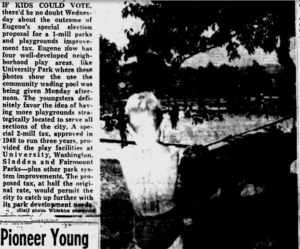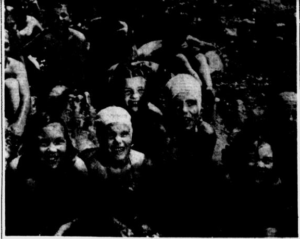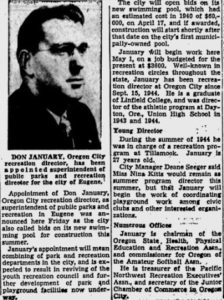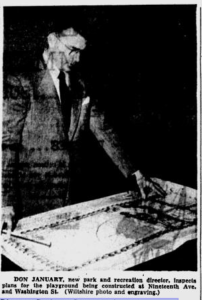
In 1951 the kids and families of Eugene had their summer dreams come true. Under the guidance of savvy Parks and Recreation Director, Don January, the funds were raised to design Eugene City parks for families and summer kids activities.
History of University Park (Last updated history by City of Eugene 9/24/03)
Address: East 24th and University Street Property Identification: 18-03-05-13-11400
Property Purchased From: Lane County
Purchase Date: 1944 initial purchase; 1945 additional purchases Purchase Cost:
Acreage: 2.81 acres
Notes: Basketball Courts; Softball Fields; Swimming/Wading Pool; Playground and Picnic Tables; Public Restrooms.
Original plans for the park were prepared by the Central Lane Planning Commission in 1947. Construction presumed to have started later that year at the earliest. Restroom building constructed in 1951 for cost of $4159.00.
A major upgrade of the park took place in 1981 with the addition of a small amphitheater seating, replacement of deteriorated asphalt paths with concrete, park benches, ballfield seating improvements, and an automatic irrigation system.
Original construction included a roque court. This was never used as such. In the late ‘80’s there was interest expressed by a few people for a place to play bocci ball. The roque court was converted for bocci, but public interest never took hold. In 2000 the area took on new play equipment as older equipment was retired from the original play apparatus location south of the wading pool.

The Wading Pool at University Park was imagined by 27 year old Eugene Parks and Recreation director Don January in 1947. Here is the new pool full of excited kids in the summer of 1951.
PARKS HISTORICAL FACTS
In 1944 the newly formed Eugene Recreation Commission found parks and recreation facilities woefully inadequate for the community’s 22,000 residents. They were tasked with assessing the shortcomings in recreation services and found plenty. Parks were minimally developed and the city, with a population of about 22,000, Eugene had no municipal playgrounds or pools. Youth recreation programs were held only in summer and the budget for playgrounds and parks was woefully inadequate to address the needs. The Commission recommended construction of a swimming pool, acquisition of five neighborhood parks and raising money through a levy to address long term needs. In 1945, the Council hired Deane Seeger away from the Boeing aircraft company as Eugene’s first city manager. Though the City Council’s wish list included investments in pool and park facilities, nothing substantial could be accomplished until the war was over.
Without any levy money for playgrounds, volunteers went to work, adopting the slogan, “Anything for the kids.” Student leaders spearheaded the fundraising campaign by going directly into the neighborhoods. And on June 18, the City’s playground program opened at six elementary schools with 1,500 children in attendance. The Register-Guard wrote that kids were playing dodge ball, making beads from macaroni, forming rhythm bands and constructing birdhouses and boats from orange crates and scrap lumber, and that the city was organizing softball programs for both girls and boys.
In 1946 the City consolidated the recreation and park programs into the new Department (or Bureau) of Parks and Recreation, with offices in City Hall and named Don January full-time superintendent.
Don January is one of Eugene’s unsung heroes in regard to parks and recreation, and certainly is the person responsible for initiating recreational facilities at University Park. At 27 years old, January came to Eugene with a vision to make the city parks the envy of any town in America with a similar population of 22,000 people. The meager city funds, and the citizen’s misunderstanding of the rewards and benefits of a healthy park system, did not deter him. He immediately set about on a marketing campaign to change the hearts and minds of the tax payers. He showed up in every local club, league and fraternal institution making the case for our neighborhood parks. He built a 60 member parks support committee from members of 26 different local organizations– in effect personally engaging each club in a larger city wide effort to support city parks. Genius. It worked. As these organizations took on the mission of committing to the park, the tax payers had a change of heart. In addition to privately raised funds, voters passed the Eugene Recreation Commission’s recommended levy and money became available for recreation and parks projects.
It was Don January who built the first public pool in Eugene. It was Don who designed and built University Park, Washington Park, and Monroe Park. It was Don who understood the importance of the wading pools, the playgrounds, the ballfields and basketball courts in building smart healthy youth for a growing Eugene.
The term “the ‘Sixties” conjures up many images in American history, but for Eugene Recreation the 1960s began a period of unmatched growth; and it started with a no vote. In May of that year, voters turned down a measure that would have provided $150,000 annually for 10 years to buy or improve a lineup of neighborhood, community and regional parks Eugene Planning. Commissioner Betty Niven, who chaired the Parks and Recreation Committee, would not accept the defeat.
Niven lobbied the City Council to appoint a Parks Study Group, which she chaired. In addition to the mayor and other powerful people, this task force included ordinary voters. The Parks Study group worked hard to find out what Eugeneans wanted and would support. Following an exhaustive series of meetings and surveys, the group re-crafted the levy. And the Better Eugene Committee campaigned for the measure with radio spots (on which Niven and others sang to guitar accompaniment) and papered the city with colorful signs saying, “Parks are for people, people are for parks.”
On May 11, 1961, Eugeneans went to the polls in record numbers. The voters agreed to a $2.4 million bond measure to construct a new City Hall. And they approved the parks levy with a 60 percent majority. This was the first of two levies that decade that would shape the Parks and Recreation scene in Eugene for many years. Betty Niven was a driving force on the Planning Commission for 14 of those years. A small South Eugene street is named for her.
SUNA UPDATE: (June 2016)
This year, 2016, the City of Eugene Department of Parks and Recreation have been hard at work structuring their budget/building plan for the next 10 years. They are basing their plans on both want and need in our local neighborhoods and the overall Eugene community.
More info on the History of Recreation can be found here.
Please power the SUN with your voice. Contact Parks and Rec here and fill out the short ideas form. Tell Parks and Rec to please make the University Park renovation a priority.
The following is a sample concept for the park renovation. We want to hear your ideas too! If you have an idea that you feel will be engaging to a particular demographic represented in the SUN, or an idea that will be of interest to everyone, please contact us at the contact tab above. Where would you like to walk with your family, dog or sweetheart? Where would you like to take friends from out of town? What sort of park can you imagine spending summer hours reading, playing, picnicking and being entertained? We want to hear about your dream smart park.
———————————————————————————————-
Sample Concept
The complete renovation of University Park (UP) in the South University Neighborhood (SUN). The concept would seamless blend sun (SUN) themed elements representing the neighborhood, with features embedding the strengths and resources of the University. ‘University’ Park would be a learning park, a place where music meets science. Early childhood development meets architecture, landscape architecture, scupture and physical fitness. A place for Shakespeare in the Park and discovery. A stunning progressive park embracing the spirit of Eugene: creative, intelligent, spirited, compassionate and embracing community.
The renovation could include:
- Sun themed layout with central gazebo for picnics or
performance with radiating pathways. Performance space may be used by UO school or music and dance students. (possible tie ins/donations with SOMD)
- Spray and play park and/or water feature to attract families
and UO early childhood development designed playground!
- a circuit of Physical fitness training around the park perimeter including fitness tips kiosk an/or placards from UO Coaches, athletes and professionals.
- A dog run with benches. The perfect destination to walk neighborhood dogs. Would create a constant stream of neighbors engaging with each other in the park. Possible ‘Dog University’ theme opportunity with tips on dog training around gate.
- Expanded amphitheater seating and stage for performance and summer movies. Tie into UO School of drama and Cinima Studies with summer schedules of vintage films. Story telling
time with UO cultural anthropologist and folklore students.
- Little Free LibraryCreative landscaping features by UO landscape architecture professor. (possible student project). With installation of indigenous species all named. A destination for UO landscape design students and classes to come see, experience, and draw native species.
- Sculpture garden. UO AAArts Department add possible annually changing park installations.
These ideas are based on preliminary canvassing of residents. They can be added to and refined as best suits the space and scope of the project.
EXPLANATION OF NEED:
University Park is the sole park and open space in the South University neighborhood.
UP has not had a renovation for over 60 years. All of the features are antiquated and of little use to the neighborhood. University Park is a key city park connecting with Amazon Neighborhood to the south and a highly visible gateway to the heavily trafficked university area.
It has the potential of being a magnet for Fairmount, Amazon, South University and the Friendly Neighborhoods, as well as visitors to the University.
University Park, though small, has the potential to be a point of neighborhood and city pride as we entertain guests from all over the world. Currently it is not representative of the creativity, intelligence and respect for nature and community spirit which we profess to value in Eugene. Since this park is not large, but does have the advantage of high visibility, I feel it should be a top priority Park for creative renovation to demonstrate the future of Eugene’s commitment to progressive planning in Parks and Open Spaces.
REQUEST TO EUGENE DEPT. OF PARKS AND REC.:
Please consider the University Park renovation as a priority project. The benefit to the neighborhood and all of Eugene is multi layered:
First, South University Neighborhood (SUN) has no other park or Open Space. It is a densely populated neighborhood with a wide diversity of residents. Contained within the blocks of the SUN are tightly packed homes and university housing units with very little to no commercial activity. The residential make up includes university students, faculty and their families, families attracted to attend the Edison elementary school, retired seniors, white and blue collar professionals. This high density of mixed age and social economic residential living, with no open space relief or common space for neighbors to connect, meet, discover and/or socialize, causes unnecessary stress to what is one of the historic Eugene neighborhoods.
The park in it’s current condition does not attract activity. The few pieces of antiquated playground equipment and their placement do not encourage creative use and family bonding. The shelter placement and style are utilitarian at best but are unattractive and poorly situated. The landscaping has been clearcut by design to prevent the gathering of undesirable activity because the park is under used currently and therefore attracts high risk activities.
We summit that intelligent landscaping and smart areas of designed interest at University Park (UP) would create a desirability factor and attract constant usage by a variety of neighbors, therefore rendering the ‘clear cut’ model unnecessary. A neighborhood that takes an interest in it’s communal spaces is self policing and protective of its asset. Basically the more eyes in the Park, the safer it will be. But those eyes need something fun to do!
In addition to improving the lives and community spirit of the SUNeighborhood residents, there is a strong case to be made that UPark has the potential to be the most used neighborhood park in all of Eugene due to it’s proximity the University itself and its situation as a link to the University and other neighborhoods. While the city is planning on a continued relationship with the Olympic trials and the SUN is flooded with out of town visitors who rent houses in the neighborhood, the local city park is a bald embarrassment.
In contrast, NW cities to the north, Portland and Seattle, have created stunning and inviting parks to welcome visitors and show off their creativity and ingenuity. Why shouldn’t the only park in the city, so close to the university and bearing the name ‘University park’, not show off the talent and creativity of the highly educated residents who populate the houses all around it?
- The South University Neighborhood only has one park. One open space. One opportunity to have a chance meeting with neighbors to build community. Currently that park is unattractive and saddle with broken and unused antiquated equipment.
- Building a stronger, more connected community creates an atmosphere of trust and safety. These elements have been desperately missing from the SUN for a long time.
- A truly innovative progressive renovation will show off Eugene to it’s greatest advantage to outsiders and visitors coming for track, marathon, trials and other university related activities.
- University park is a gateway and connected to adjacent neighborhoods.
- The small size of the park allows for greater creativity in a complete head to toe renovation.
NEIGHBORHOOD SUPPORT:
This project will require both city and private financial support.
We intend to launch a strong SUN UP fundraising campaign to support this project.
We do not see this a revenue generation project. This is an important out reach and community building project. However,we do feel that interest in the Park will generate enough annual funds to sustain operations and maintenance with the support of a ‘Friends of SUN UP’ organization.


